Quick Summary:
If you’re a supply chain leader, decision-maker, or innovator, you know the pressure to stay ahead. AI in supply chain is reshaping the game, offering smarter solutions to complex challenges. This blog is your guide to leveraging AI for streamlined operations, better decisions, and sustainable success.
In this blog, we’re going to discuss📝
Artificial Intelligence (AI) is revolutionizing the supply chain industry by addressing inefficiencies, predicting challenges, and introducing automation. The integration of AI transforms traditional operations into streamlined, resilient, and customer-focused systems. Let’s explore its overarching purpose and key takeaways:
Purpose of AI in Supply Chain:
- Enhance efficiency through automation and real-time insights.
- Improve customer satisfaction with predictive and personalized services.
- Build resilience against disruptions by leveraging data-driven strategies.
- Align operations with sustainability goals.
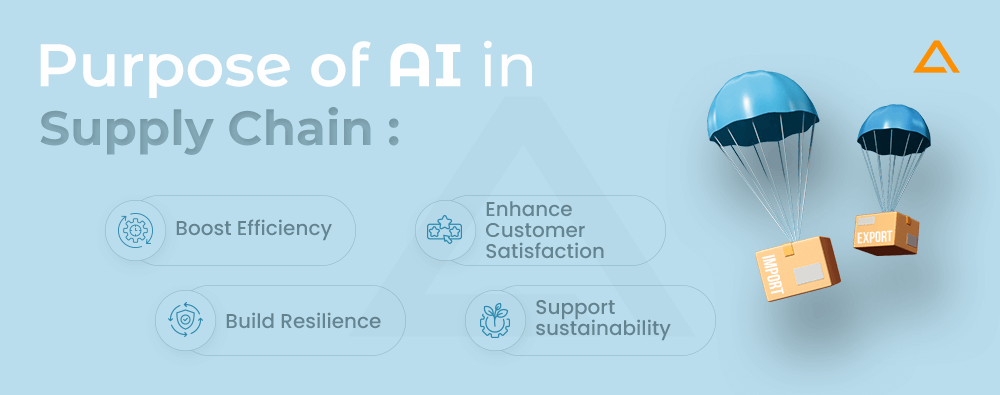
Impact of AI on SCM Industry: Stats, Popularity & Market Share
AI in Supply Chain Market Size is already making big waves and is being adapted by companies of all sizes to optimize their supply chain operations. Here are some credible resources highlighting the popularity of AI in Supply Chain:
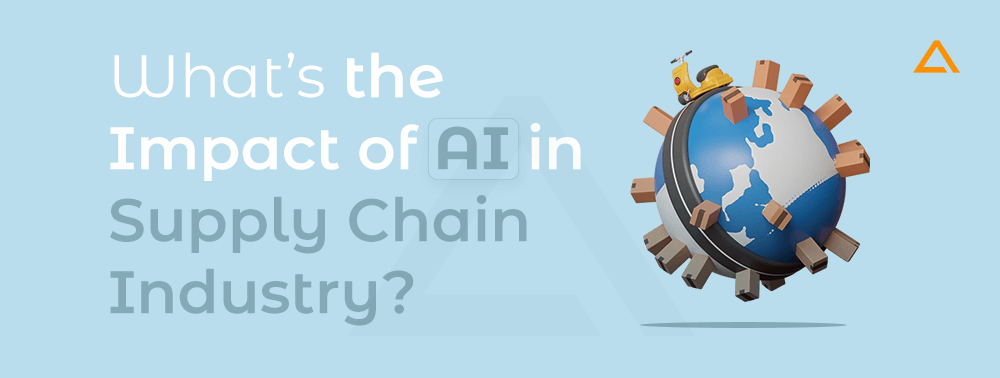
- As per a study conducted by McKinsey & Company, AI-enabled supply chain management enabled early adopters to improve logistics by 15%, inventory levels by 35% and service levels by 65%.
- In a study published on Statista, The Asia/Pacific region is leading in utilizing AI and ML technologies in supply lines from 2023 to 2025.
- As per GrandViewResearch, the global artificial intelligence in supply chain market size was estimated to be 5.05 billion in 2023 with expectations to grow at a CAGR of 38.9% from 2024-2030.
Top 12 AI in Supply Chain Use Cases
Now that we’ve outlined the purpose of AI in supply chains, let’s dive into specific use cases where AI is making a tangible impact. These applications showcase how AI enhances various elements of the supply chain, from inventory management to customer experience, improving overall performance.
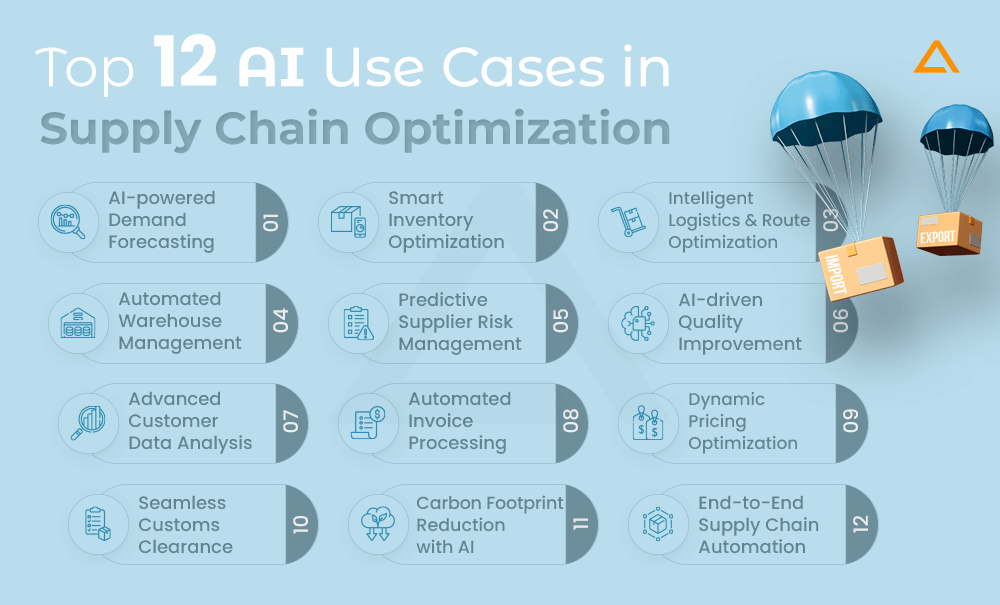
1. Demand Forecasting
AI has become a game-changer in demand forecasting, helping businesses make smarter, data-driven decisions. Unlike traditional methods, AI can analyze vast amounts of data to predict future demand with high accuracy.
This ability provides several key benefits that improve operational efficiency and drive business success:
- Accurate Predictions: AI analyzes historical data, market trends, seasonality, and external factors like competitor behavior to deliver precise forecasts.
- Improved Inventory Management: With accurate demand insights, businesses can avoid stockouts and overstocking, reducing waste and saving costs.
- Real-Time Adaptability: AI responds to shifting patterns quickly, making it ideal for dynamic industries like retail, manufacturing, and e-commerce.
- Enhanced Strategic Planning: Long-term forecasting powered by machine learning helps businesses plan for growth and adapt to future trends.
- Better Customer Experience: By anticipating demand, companies can ensure product availability, boosting customer satisfaction.
2. Inventory Optimization
AI plays a transformative role in inventory optimization by enabling businesses to manage their stock more efficiently and effectively. Traditional inventory management often struggles to balance demand fluctuations, supply chain complexities, and operational constraints. AI addresses these challenges by leveraging advanced algorithms and real-time data analysis.
Key benefits of AI in inventory optimization include:
- Demand Forecasting: AI accurately predicts future demand patterns based on historical data, market trends, and external factors, ensuring optimal stock levels.
- Real-Time Monitoring: AI systems track inventory in real-time, providing instant visibility into stock levels and identifying discrepancies or inefficiencies.
- Dynamic Reordering: AI can automate reorder processes by analyzing lead times, supplier performance, and demand trends to maintain ideal inventory levels.
- Reduced Holding Costs: By optimizing stock quantities, AI minimizes excess inventory, reducing storage costs and the risk of obsolescence.
- Enhanced Supply Chain Efficiency: AI helps coordinate production, procurement, and distribution to align with actual demand, reducing bottlenecks and delays.
- Risk Management: AI anticipates disruptions, such as supply chain delays or demand surges, and provides actionable insights to mitigate their impact.
3. Logistics and Route Optimization
AI is revolutionizing logistics and route optimization by providing smarter, faster, and more cost-effective solutions to manage supply chain operations. Traditional methods often fall short in addressing the complexities of modern logistics, such as fluctuating demand, unpredictable traffic conditions, and rising fuel costs. AI overcomes these challenges by using advanced algorithms and real-time data analysis.
Key applications of AI in logistics and route optimization include:
- Efficient Route Planning: AI-powered systems analyze real-time traffic, weather conditions, and delivery constraints to create the most efficient routes, saving time and fuel costs.
- Dynamic Adjustments: AI enables real-time re-routing to account for sudden changes like road closures or traffic congestion, ensuring timely deliveries.
- Load Optimization: AI optimizes vehicle capacity by determining the most efficient way to load goods, reducing trips and transportation costs.
- Predictive Maintenance: By monitoring vehicle performance, AI can predict maintenance needs, preventing breakdowns and reducing downtime.
- Enhanced Fleet Management: AI helps allocate vehicles and resources efficiently, balancing workloads and maximizing productivity.
- Sustainability Goals: By optimizing routes and reducing fuel consumption, AI supports environmentally friendly logistics operations
4. Warehouse Automation
AI is driving significant advancements in warehouse automation by enabling smarter, more efficient, and highly adaptive operations. Traditional warehousing methods often rely on manual labor and static processes, which can be time-consuming, error-prone, and costly. AI revolutionizes these systems by introducing intelligent automation and real-time decision-making.
Key applications of AI in warehouse automation include:
- Robotic Process Automation: AI-powered robots can pick, pack, and sort items with precision, reducing human error and increasing speed.
- Inventory Management: AI systems monitor inventory levels in real time, predict restocking needs, and prevent overstocking or stockouts.
- Smart Storage Optimization: AI identifies the best storage locations for items based on demand patterns, minimizing retrieval time and maximizing space utilization.
- Demand Forecasting: By analyzing sales data and trends, AI helps warehouses prepare for fluctuations, ensuring smooth operations during peak periods.
- Automated Quality Control: AI-based vision systems can inspect products for defects faster and more accurately than manual inspections.
- Predictive Maintenance: AI monitors equipment performance to predict maintenance needs, preventing downtime and ensuring operational continuity.
- Enhanced Safety: AI systems use sensors and cameras to identify potential hazards, improving worker safety in high-risk environments.
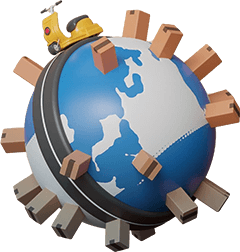
Searching for Supply Chain IT Solutions?
Optimize supply chain and warehousing with our cutting-edge solution – enhancing efficiency, reducing costs, and improving workflows with agility and transparency.
5. Supplier Management and Risk Prediction
AI is transforming supplier management and risk prediction by offering businesses deeper insights, proactive strategies, and improved decision-making capabilities. Traditional methods often fall short in identifying risks or optimizing supplier relationships due to their reliance on static data and manual processes. AI overcomes these limitations by analyzing vast datasets, identifying patterns, and predicting potential disruptions.
Key applications of AI in supplier management and risk prediction include:
- Supplier Performance Analysis: AI evaluates supplier performance using metrics like delivery timelines, quality, and cost-effectiveness, helping businesses make data-driven decisions.
- Risk Identification: AI analyzes supply chain data to identify risks such as supplier financial instability, geopolitical disruptions, or compliance violations.
- Predictive Analytics: AI predicts potential disruptions by analyzing external factors like market trends, weather conditions, or political events, enabling proactive mitigation.
- Contract Optimization: AI streamlines contract management by analyzing terms and ensuring compliance, reducing legal and financial risks.
- Cost Optimization: By analyzing procurement data, AI identifies cost-saving opportunities through better supplier selection or negotiation strategies.
- Fraud Detection: AI detects anomalies in supplier transactions or behaviors, flagging potential fraud or unethical practices.
- Sustainability Monitoring: AI evaluates suppliers based on sustainability metrics, ensuring alignment with environmental and social governance (ESG) goals.
6. Quality Improvement
AI is revolutionizing quality control in supply chain management (SCM) by providing real-time insights, enhancing accuracy, and driving operational efficiency. Traditional quality control methods often rely on manual inspections, which can be slow and prone to human error. AI automates and refines these processes, offering smarter solutions that improve product quality while reducing costs.
Key applications of AI in SCM quality control include:
- Real-Time Monitoring: AI uses sensors and IoT devices to monitor products and processes in real time, ensuring that quality standards are met at every stage of production and distribution.
- Automated Inspections: AI-powered computer vision systems can identify defects or inconsistencies in products during manufacturing or packaging, providing faster and more accurate inspections than human workers.
- Predictive Maintenance: AI predicts equipment failures or process deviations by analyzing historical data, reducing the likelihood of defects caused by machinery breakdowns.
- Data-Driven Decision Making: AI analyzes large datasets from multiple sources to uncover quality trends, identifying root causes of quality issues and suggesting corrective actions.
- Supply Chain Transparency: AI tracks product quality across the entire supply chain, from raw materials to finished goods, ensuring that suppliers meet agreed-upon standards.
- Anomaly Detection: AI detects anomalies in production processes or product characteristics, enabling rapid responses to quality issues before they impact large batches.
- Process Optimization: AI helps optimize workflows by identifying inefficiencies in production, logistics, or distribution, ensuring that quality control measures are consistently applied.
7. Customer Data Analysis
AI is transforming customer data analysis by enabling businesses to gain deeper insights into customer behavior, preferences, and trends, ultimately improving customer experiences and driving growth. Traditional methods of analyzing customer data are often limited in scope and speed, while AI leverages advanced algorithms to process large volumes of data, identifying patterns and predicting future behaviors.
Key applications of AI in customer data analysis include:
- Customer Segmentation: AI analyzes customer data to identify distinct groups based on factors like purchasing behavior, demographics, and preferences, enabling personalized marketing and product offerings.
- Predictive Analytics: AI predicts future customer behavior by analyzing past interactions, helping businesses anticipate needs and deliver relevant products or services.
- Sentiment Analysis: A skilled NLP engineer leverages AI-driven natural language processing (NLP) to analyze customer feedback, reviews, and social media posts, providing insights into customer sentiment and brand perception.
- Churn Prediction: AI models can identify customers who are likely to stop using a product or service, allowing businesses to take proactive measures to retain them through targeted campaigns or offers.
- Recommendation Systems: AI powers personalized recommendations by analyzing customer purchase history and preferences, driving upsell and cross-sell opportunities.
- Customer Journey Mapping: AI tracks customer interactions across multiple touchpoints, providing a comprehensive view of their journey and helping businesses optimize their marketing and customer service strategies.
- Fraud Detection: AI identifies unusual customer behavior or transaction patterns, helping businesses detect and prevent fraudulent activity.
8. Invoice Processing Automation
AI is revolutionizing invoice processing automation by streamlining the entire workflow, from data extraction to validation and payment processing. Using technologies like natural language processing (NLP) and optical character recognition (OCR), AI can accurately extract relevant information from invoices, such as vendor details, amounts, and dates.
This automated process helps to:
- Improve Accuracy: AI reduces human errors in data entry by accurately extracting and validating information from invoices.
- Flag Discrepancies: AI can automatically identify discrepancies between invoice details and purchase orders, notifying teams of potential issues for quick resolution.
- Accelerate Approval Workflows: AI automates approval processes by routing invoices to the appropriate departments, ensuring quicker decision-making and faster payment cycles.
- Enhance Financial Transparency: By providing real-time insights into invoice statuses and payment histories, AI ensures greater visibility into financial operations.
- Minimize Manual Intervention: Automation reduces the need for manual data entry and handling, freeing up time for employees to focus on more strategic tasks.
- Streamline Accounts Payable: AI optimizes the accounts payable cycle, improving cash flow management and reducing processing times.
9. Pricing Optimization
AI is significantly enhancing pricing optimization by enabling businesses to dynamically adjust prices based on market conditions, customer behavior, and competitive landscapes. Traditional pricing strategies often rely on fixed pricing models or periodic adjustments, which may not respond quickly enough to market changes. AI, however, uses advanced algorithms and real-time data analysis to make more informed and agile pricing decisions.
Key applications of AI in pricing optimization include:
- Dynamic Pricing: AI analyzes real-time market data, competitor pricing, demand fluctuations, and consumer behavior to adjust prices dynamically, ensuring businesses remain competitive while maximizing revenue.
- Price Sensitivity Analysis: AI models help businesses understand how different customer segments respond to price changes, allowing for tailored pricing strategies that optimize sales and profits.
- Demand Forecasting: AI predicts future demand based on historical data, seasonal trends, and market conditions, helping businesses set prices that balance demand with supply availability.
- Competitor Monitoring: AI continuously tracks competitor pricing and adjusts a business’s prices in real time to maintain competitive advantage without compromising profitability.
- Personalized Pricing: AI allows businesses to offer personalized pricing or discounts based on customer data, enhancing customer satisfaction and loyalty while maximizing revenue per customer.
- Profitability Optimization: AI identifies the most profitable price points for products or services by analyzing costs, demand elasticity, and profit margins.
- Price Testing: AI can automate A/B testing of pricing models to determine the most effective pricing strategies for different markets or customer groups.
10. Streamlining Customs Clearance
AI is revolutionizing the process of customs clearance by automating tasks, enhancing efficiency, and reducing the time and complexity involved in cross-border trade. Traditional customs procedures can be slow and prone to errors, leading to delays and increased costs. AI streamlines customs clearance by leveraging machine learning, natural language processing (NLP), and data analytics to improve decision-making and ensure compliance.
Key applications of AI in streamlining customs clearance include:
- Automated Document Processing: AI-powered optical character recognition (OCR) and NLP technologies can automatically extract and analyze key information from customs documents (e.g., invoices, shipping manifests) to ensure accurate data submission and minimize human error.
- Risk Assessment and Compliance: AI algorithms assess the risk of shipments based on historical data, transaction patterns, and regulations, flagging shipments that may require further inspection or additional documentation to ensure compliance.
- Customs Classification: AI can automatically classify goods according to their harmonized system (HS) codes, reducing the likelihood of misclassification and avoiding potential penalties.
- Predictive Analytics: AI analyzes data from multiple sources to predict potential delays or issues in the customs process, allowing businesses to proactively address potential bottlenecks and improve efficiency.
- Intelligent Decision-Making: AI enables smarter decision-making by analyzing vast amounts of data and making recommendations on the best course of action, such as identifying the most efficient customs route or suggesting alternative solutions in case of delays.
- Process Optimization: AI can optimize the overall customs clearance process by automating repetitive tasks, improving document management, and reducing manual interventions, leading to faster processing times.
- Real-Time Tracking and Updates: AI-powered systems provide real-time tracking and notifications about the status of shipments, helping businesses stay informed and manage logistics more effectively.
11. Reducing Carbon Footprint
AI is playing a crucial role in helping businesses reduce their carbon footprint within the supply chain by optimizing processes, improving resource efficiency, and enabling more sustainable practices. Traditional supply chain management often leads to inefficiencies, waste, and unnecessary emissions. By leveraging AI, businesses can make smarter decisions that lower emissions, reduce waste, and promote sustainability.
Key applications of AI in reducing carbon footprint in the supply chain include:
- Optimized Routing and Transportation: AI-powered route optimization minimizes fuel consumption by selecting the most efficient delivery paths, taking into account factors like traffic, weather, and road conditions. This reduces emissions from transportation, one of the largest contributors to carbon footprints.
- Demand Forecasting: AI improves demand forecasting accuracy, preventing overproduction and excess inventory, which in turn reduces waste and unnecessary energy consumption in manufacturing and warehousing.
- Energy Management: AI helps monitor and manage energy use in production facilities and warehouses by predicting energy demand and adjusting operations to reduce energy waste, contributing to lower carbon emissions.
- Sustainable Sourcing: AI analyzes supplier data to identify those who adhere to sustainable practices, helping businesses make more environmentally conscious decisions when sourcing materials and products.
- Inventory Optimization: AI ensures inventory is maintained at optimal levels, avoiding overstocking and reducing the need for energy-intensive storage and transportation of excess goods.
- Circular Supply Chains: AI supports the development of circular supply chains by identifying opportunities for recycling and reusing materials, reducing waste, and lowering the carbon impact of manufacturing processes.
- Carbon Emission Tracking: AI-powered systems track and monitor carbon emissions across the entire supply chain, providing businesses with real-time insights into their carbon footprint and helping them set targets for emission reductions.
12. Supply Chain Automation
AI is significantly enhancing supply chain automation by streamlining operations, improving efficiency, and reducing human intervention. Traditional supply chain processes often involve complex, manual tasks that can be time-consuming, error-prone, and resource-intensive. AI-powered automation, however, leverages advanced algorithms, machine learning, and real-time data to optimize and accelerate various stages of the supply chain.
Key applications of AI in supply chain automation include:
- Automated Inventory Management: AI systems monitor inventory levels in real time, automatically reordering stock when needed and optimizing storage to reduce excess or stockouts. This helps maintain balance and efficiency in inventory management.
We worked for a client that needed smart inventory management solutions for their Japan-based housing ecommerce business. Check out that case study if you want to learn more – Inventory Management Solution for Furniture Marketplace
- Demand and Planning: AI analyzes historical sales data, market trends, and external factors to predict future demand accurately. This enables more precise production planning, reducing excess inventory and preventing shortages.
- Robotic Process Automation (RPA): AI-driven robots automate repetitive tasks such as sorting, picking, packing, and labeling goods in warehouses, speeding up the fulfillment process and reducing the need for manual labor.
- Dynamic Routing and Delivery Optimization: AI optimizes delivery routes by analyzing traffic conditions, weather forecasts, and customer locations in real-time, ensuring faster and more cost-efficient deliveries.
- Supplier Management: AI automates the selection and evaluation of suppliers, monitoring supplier performance, identifying potential risks, and ensuring consistent quality, leading to more effective supplier relationships and improved procurement strategies.
- Predictive Maintenance: AI predicts when equipment or machinery is likely to fail, enabling proactive maintenance and reducing downtime, which ensures smoother supply chain operations.
- Order Fulfillment Automation: AI-powered systems automate order processing, from order receipt to delivery, ensuring faster, more accurate fulfillment and reducing the risk of errors.
- Real-Time Tracking and Visibility: AI enhances real-time tracking of goods in transit, providing stakeholders with up-to-date information on the status of shipments and enabling quick response to any disruptions.
AI in Supply Chain Real-World Case Studies
In real-world applications, businesses are already experiencing the benefits of AI in their supply chains. Below are a few examples of how AI is being applied successfully across various industries:
1. Walmart: Packing & Routing Optimization
Walmart’s AI-powered route optimization is a key example of technology transforming supply chains. By optimizing driving routes and trailer packing, Walmart reduced CO2 emissions by 94 million pounds and avoided 30 million unnecessary miles.
Recognized with the 2023 Franz Edelman Award, Walmart now offers this technology as a SaaS solution, enabling other businesses to improve delivery efficiency, plan multi-stop routes, and optimize trailer space. Walmart’s success highlights AI’s role in boosting supply chain efficiency, sustainability, and resilience.
2. Unilever Transforms Supply Chain Efficiency with AI
Unilever’s AI-driven supply chain model enhances collaboration with customers by integrating real-time sales and forecast data, optimizing planning, forecasting, and replenishment processes. This approach removes traditional barriers between supply chains, creating a seamless ecosystem that improves forecasting accuracy and strengthens supply chain resilience.
The model optimizes distribution and store inventory, reducing the number of truck trips and ensuring timely deliveries. By leveraging AI and digital tools, Unilever’s strategy allows teams to focus on more strategic tasks while ensuring products are available to consumers when needed.

Seeking brilliance in the AI/ML universe?
Look no further!
Conclusion: Embracing the AI Revolution
AI is redefining supply chain management by turning challenges into opportunities and inefficiencies into streamlined processes. Businesses leveraging AI can:
- Predict demand and optimize inventory.
- Improve customer experiences with personalization and real-time tracking.
- Build resilient supply chains capable of weathering disruptions.
- Align with sustainability goals for a greener future.
By embracing AI, companies can stay competitive in an evolving marketplace, driving long-term growth and success in the global supply chain ecosystem.
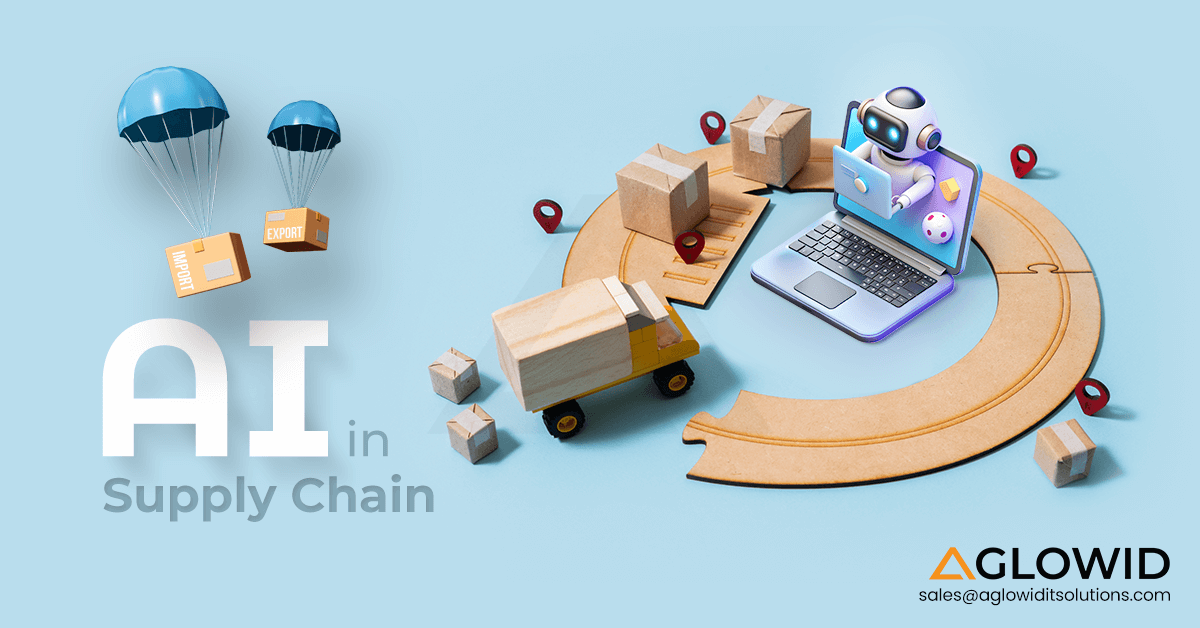

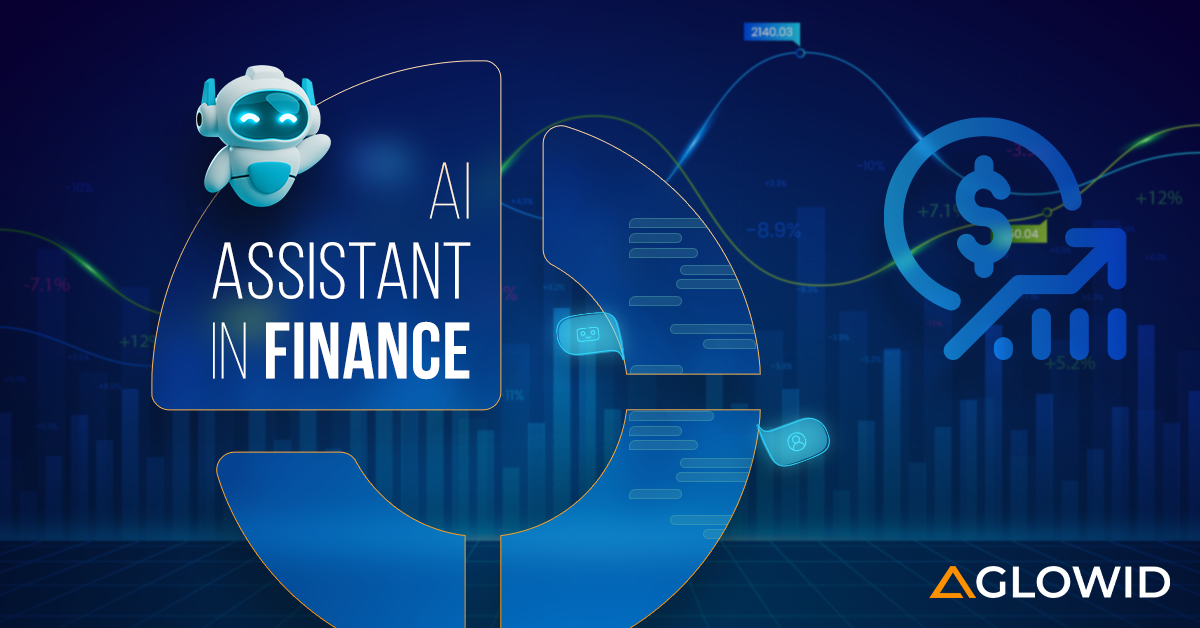
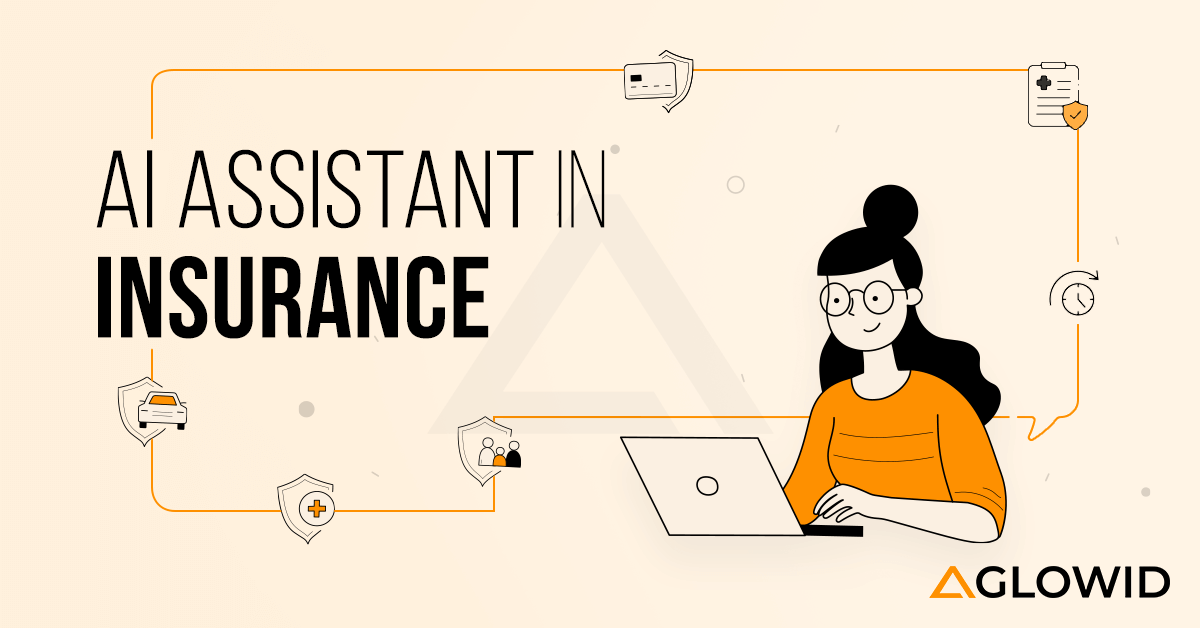

 Say
Say